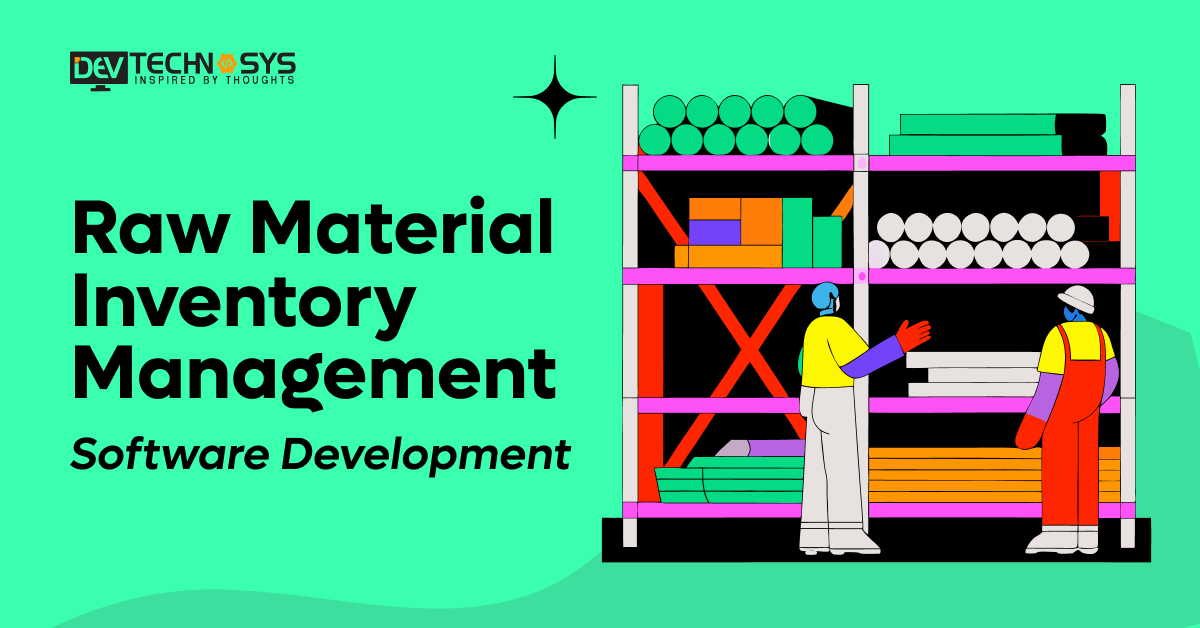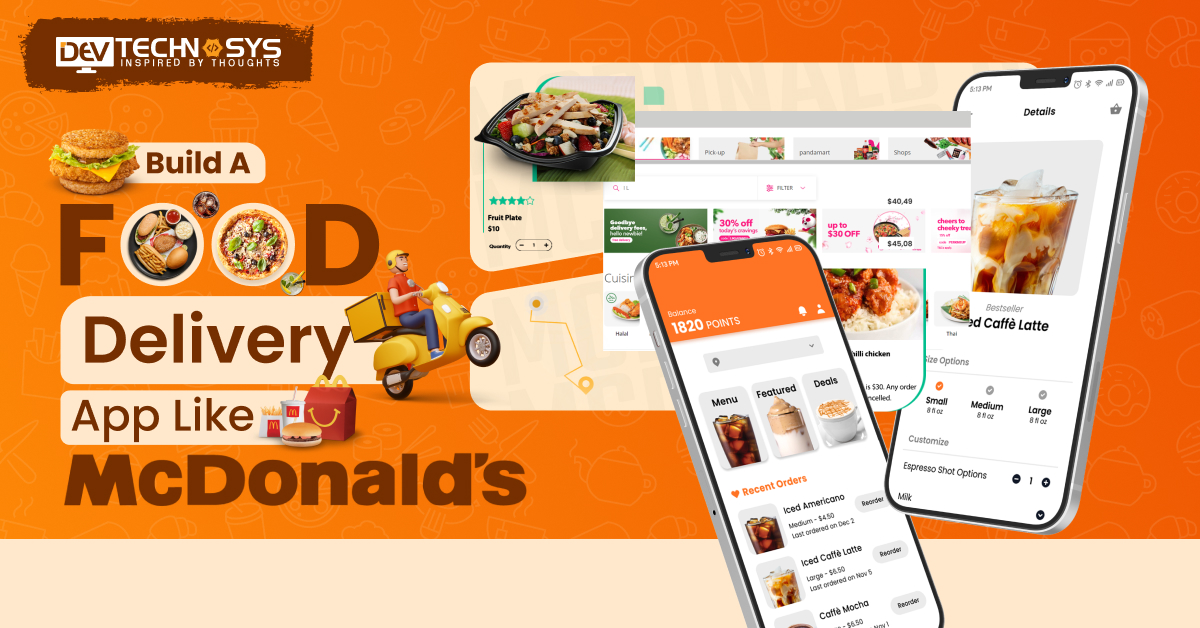“Boost Production Efficiency”
Facing issues with material shortages, excess stock, and inconsistent inventory optimization efforts? Then, there’s no need to worry about it. Raw material inventory management software helps businesses manage their inventories and get accurate reports of goods. It allows businesses to streamline their operations, reduce wastage, and plan in real-time.
According to the global market, the raw material inventory management software was valued at around $2.31 billion in 2024; it is projected to grow to around $4.79 billion by the end of 2032.
This data depicts that investing in the raw material inventory management software is a profit-generating opportunity for businesses.
In this blog, we will explore the raw material inventory management software development and how it provides benefits to real-world businesses.
Stay on!
What is Raw Material Inventory Management Software?
Raw Material Inventory Management Software is a digital application that enables firms to monitor, track, and manage raw materials used in manufacturing. It guarantees proper stock levels, reduces waste, increases procurement efficiency, and enables precise forecasting. If you develop an app like Sortly, it provides real-time inventory information and interaction with other systems, simplifies operations, and improves supply chain decision-making.
- Real-Time Inventory Tracking
- Automated Reordering
- Batch and Lot Tracking
Market Analysis of Raw Material Inventory Management Software
- The estimated value of raw material inventory management software was $2.31 billion in 2024, and by the end of 2032, it is expected to have grown to $4.79
- At a compound annual growth rate of 7%, the worldwide inventory management software market is projected to reach USD 5.08 billion by 2030.
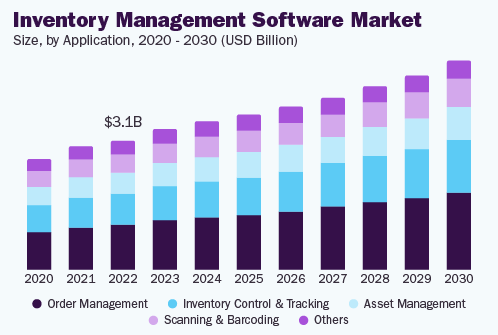
- With a revenue share of over 34% in 2024, the North American region led the inventory management software market.
- Among the major companies in the inventory management software industry are IBM Corporation, Microsoft Corporation, and Oracle Corporation.
- The market for inventory management software is expanding rapidly due to companies’ need to improve operational efficiency, save expenses, and optimize supply chains.
Top 10 Raw Material Inventory Management Software
Clearly! The best inventory management applications as of 2025 is shown here, together with their start year, special characteristic, and expected internet traffic:
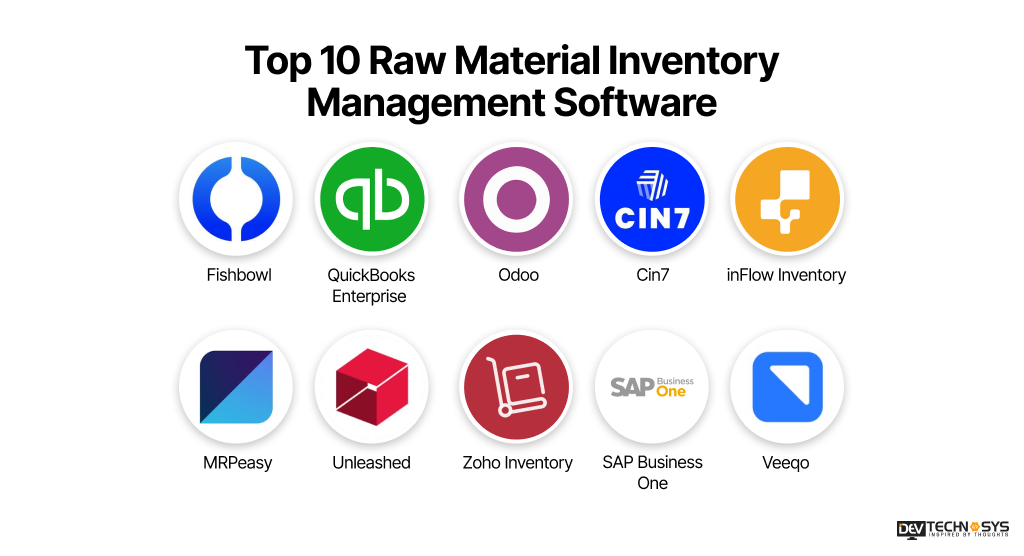
Software |
Special Feature |
Estimated Monthly Traffic |
Launched Year |
| Fishbowl | Advanced manufacturing and warehouse management | ~50,000 visits
|
2001 |
| QuickBooks Enterprise | Integrated accounting and inventory management | ~40,000 visits
|
1983 |
| Odoo | Modular ERP with customizable inventory modules | ~60,000 visits
|
2005 |
| Cin7 | Omnichannel inventory management with POS integration | ~30,000 visits
|
2010 |
| inFlow Inventory | User-friendly interface with barcode scanning | ~20,000 visits
|
2009 |
| MRPeasy | Cloud-based MRP for small manufacturers | ~15,000 visits
|
2015 |
| Unleashed | Real-time inventory tracking with batch and serial number support | ~25,000 visits
|
2012 |
| Zoho Inventory | Seamless integration with Zoho suite and e-commerce platforms | ~35,000 visits | 2014 |
| SAP Business One | Comprehensive ERP with advanced inventory and financial management | ~45,000 visits
|
2002 |
| Veeqo | Multi-channel retail and warehouse management | ~10,000 visits
|
2015 |
Why do Entrepreneurs Invest in Raw Material Inventory Management Software Development?
Entrepreneurs invest in raw material inventory management software to gain real-time visibility, reduce waste, and streamline production. This technology enables accurate tracking, better demand forecasting, and cost control. It supports data-driven decisions and scalable growth, giving businesses a competitive edge in managing raw materials efficiently.
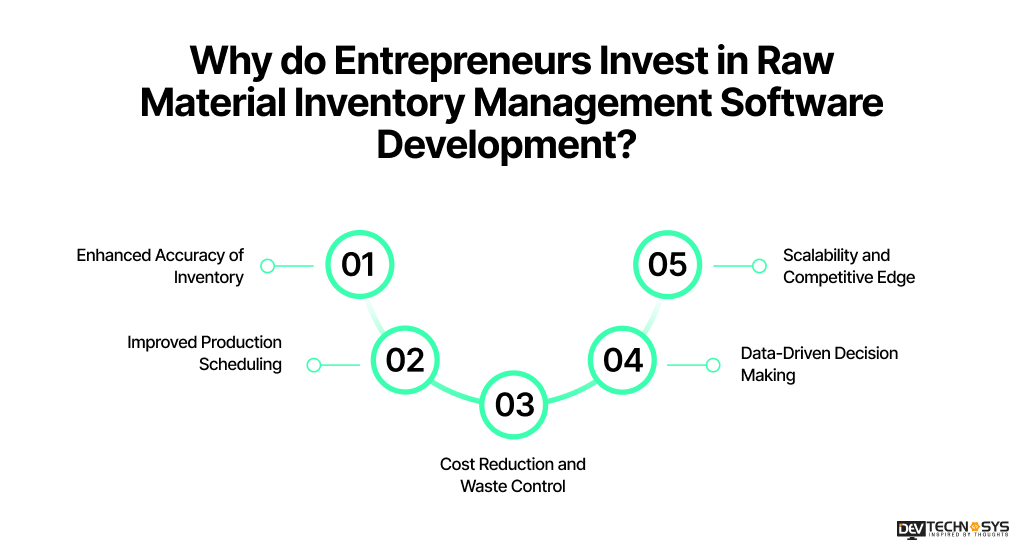
1. Enhanced Accuracy of Inventory
Accurate data is first importance for entrepreneurs making decisions. By automating stock tracking, real-time inventory level updating, and material use visibility, raw material inventory management software reduces human error.
The raw material inventory management software development services guarantees that companies steer clear of expensive problems such understocking, overstocking, or raw material waste.
2. Improved Production Scheduling
Quick access to inventory data simplifies manufacturing lines. Investors in such systems make sure that raw resources are constantly accessible as required. Accurate predictions and reorder warnings help to maintain production schedules unbroken.
Important for keeping customer happiness and competitive advantage, this lowers downtime, increases production, and enables businesses to achieve delivery targets.
3. Cost Reduction and Waste Control
The best inventory management software can lead to overabundance or spoilage from inadequate tracking. Better resource planning made possible by software solutions helps companies to keep ideal stock levels and save storage expenses. Viewed as a strategic investment, entrepreneurs perceive this lowering of operating costs, waste reduction, and, over time, profit margin enhancement.
4. Data-Driven Decision Making
Strategically growing entrepreneurs appreciate insights. Analytics and reporting capabilities included in the material inventory management system give information on demand variations, supplier performance, and consumption patterns. These realizations enable companies’ management to negotiate better terms with suppliers, make wiser procurement choices, and spot areas for process development.
5. Scalability and Competitive Edge
Manual inventory systems are unsustainable as companies get larger. If you build a chatbot for inventory management, it supports multi-location inventories, supplier integration, and market development into new areas.
Which are investments made by entrepreneurs in not only future-proofing operations but also offering a competitive edge by allowing quicker, more responsive supply chain management, therefore strengthening a strong system.
How AI Can Help Raw Material Inventory Management Software?
- AI analyzes historical data to forecast raw material demand, optimizing stock levels and reducing waste.
- AI identifies trends and triggers automatic reordering of materials to prevent stockouts or overstocking.
- AI algorithms predict future material needs based on market trends, seasonality, and historical data patterns.
- AI adjusts material prices based on demand, availability, and market trends, improving procurement cost control.
- AI detects unusual inventory fluctuations, identifying discrepancies like theft, spoilage, or errors in real-time.
How to Build a Raw Material Inventory Management Software?
To create a raw material inventory management software, it involves defining business requirements, designing a scalable system architecture, selecting the right tech stack, and developing core features like tracking, alerts, and reporting. Testing, deployment, and continuous updates ensure the software remains efficient and user-friendly. So, here we provide AI inventory management software development process:
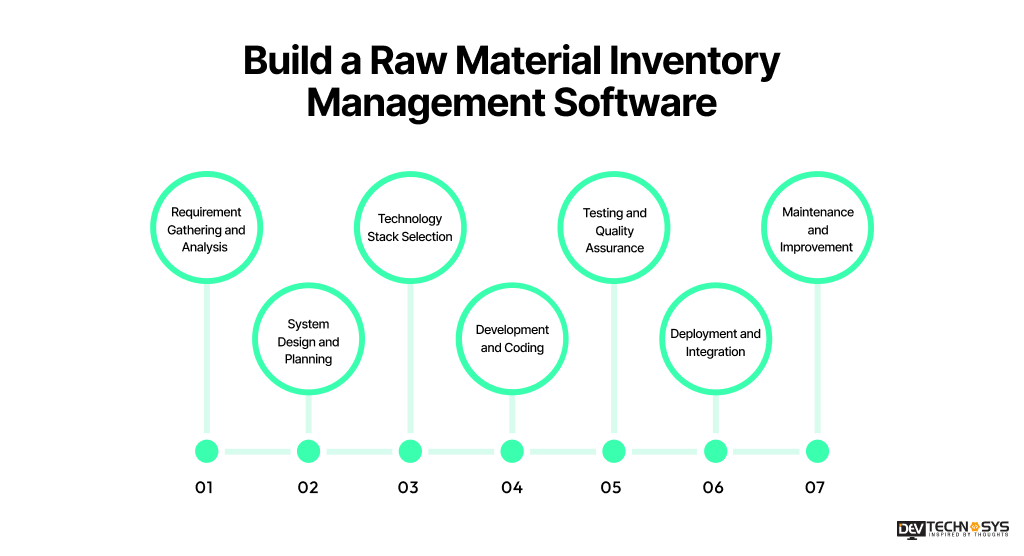
1. Requirement Gathering and Analysis
This stage involves identifying the specific needs of the business, including inventory volume, material types, supplier integration, and reporting requirements. Stakeholders collaborate to define goals, system functionalities, and technical constraints. Hire software developer to understand the user expectations and operational workflows is essential to design a tailored and efficient inventory management solution.
2. System Design and Planning
The system’s architecture is created, detailing database structures, user interfaces, and integration points with existing systems like ERP or procurement platforms. Wireframes, data flow diagrams, and design specifications are prepared. This blueprint ensures the software meets business needs while remaining scalable, secure, and easy to use for future enhancements or expansions.
3. Technology Stack Selection
You can hire a custom software development company to choose suitable programming languages, frameworks, and tools based on performance, security, and scalability needs. Considerations include cloud vs. on-premise deployment, database technologies (like MySQL or MongoDB), and integration capabilities with other platforms.
This step ensures the software is built on a robust, maintainable, and efficient technological foundation aligned with long-term goals.
4. Development and Coding
The software is built in modules, including features like material tracking, reorder alerts, supplier management, and reporting dashboards. Agile or iterative development methods are often used for flexibility. Regular code reviews, version control, and unit testing are applied to ensure quality, functionality, and security throughout the entire development process.
5. Testing and Quality Assurance
In the fifth stage of supplychain management software development stage, comprehensive testing is conducted to ensure the software functions correctly under various conditions. This includes functional testing, integration testing, performance testing, and user acceptance testing (UAT). Bugs are identified and resolved. The goal is to deliver a stable, secure, and user-friendly system that meets the specified business and technical requirements.
6. Deployment and Integration
After successful testing, the software is deployed in the live environment. It’s integrated with existing systems such as finance, ERP, or production planning tools. Data migration is performed, and system configurations are fine-tuned. Training sessions are held to ensure users are comfortable operating the system effectively from day one.
7. Maintenance and Continuous Improvement
Post-launch, the software is monitored for performance and user feedback. Regular updates are released to fix bugs, enhance features, and adapt to evolving business needs. Hire a raw material inventory management software development company for support services to ensure minimal downtime.
Continuous improvement through analytics and user suggestions keeps the software efficient, reliable, and aligned with the company’s growth.
Raw Material Inventory Management Software Development for a Wide Range of Industries
Raw material inventory management software is essential across various industries, including manufacturing, pharmaceuticals, construction, and electronics. It optimizes stock control, streamlines procurement, and ensures efficient supply chain management.
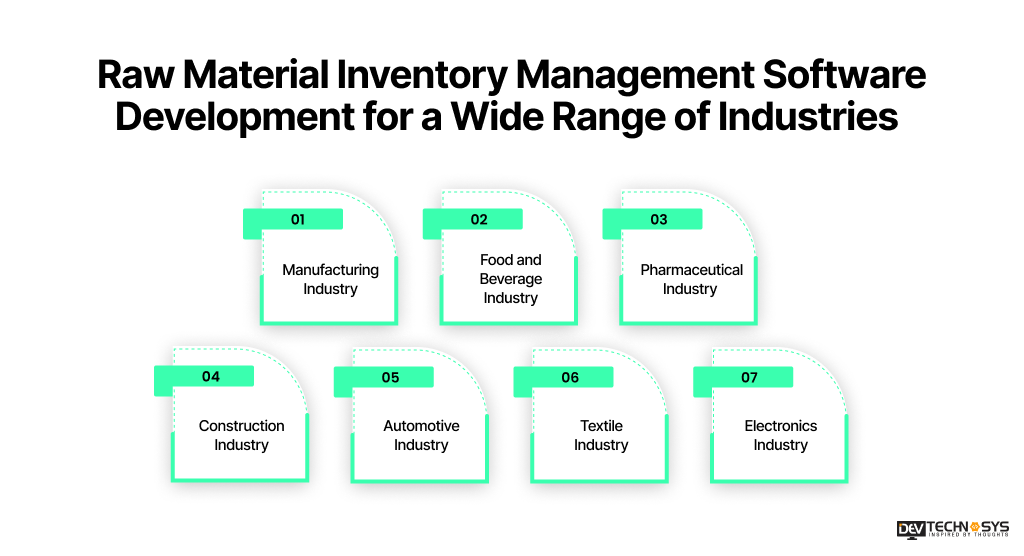
1. Manufacturing Industry
Raw material inventory management software for the manufacturing industry maintains appropriate stock levels, reduces production delays, and increases order accuracy. Manufacturing inventory tracking software records goods from suppliers, analyzes use, and automates refilling, so speeding manufacturing operations and eliminating waste.
2. Food and Beverage Industry
Raw material inventory management software is used in the food sector to track perishable commodities and ensure that they meet expiry dates and quality requirements. It automates reorder notifications, controls batch output, and enhances traceability to save waste and preserve freshness.
3. Pharmaceutical Industry
Pharmaceutical businesses use inventory software to manage raw commodities such as active pharmaceutical ingredients (APIs). If you develop hospital inventory management software, it maintains regulatory compliance, controls shelf life, and avoids stockouts. Integrating batch tracking guarantees quality control and traceability across the supply chain.
4. Construction Industry
Construction projects need raw material management software to track building supplies such as cement, steel, and timber. The program assists in monitoring stock levels across many sites, managing supplier orders, and optimizing material utilization in order to avoid project delays and decrease costs.
5. Automotive Industry
Inventory management software is used in car production to track raw materials including metals, polymers, and rubber. The program interacts with production schedules, automates ordering procedures, and guarantees resources are delivered on time, decreasing downtime and enhancing production efficiency.
6. Textile Industry
Textile raw material inventory management facilitates the tracking of fabrics, dyes, and trimmings. The program enhances inventory management, automates ordering procedures, and reduces waste. It also guarantees that production schedules coincide with material availability, which improves workflow efficiency and lowers costs.
7. Electronics Industry
Raw material inventory management software helps electronics manufacturers track components such as semiconductors, resistors, and circuit boards. It helps to optimize procurement, monitor stock levels, and automate reordering procedures, ensuring that manufacturing lines function smoothly and without shortages while also boosting supply chain visibility.
10 Essential and Premium Features of Raw Material Inventory Management Software
These important and premium capabilities enable firms to optimize raw material management, increase operational efficiency, and foster strategic growth.

1. Real-Time Tracking of Inventory
Offers realtime information on material levels at several sites, therefore enabling companies to prevent overstocking or stock outs.
2. Reordering Automatically
When inventory hits pre-defined levels, triggers automatic buy orders to guarantee resources are always accessible without human involvement.
3. Demand Projection
Forecasts material demands using historical data and predictive analytics, therefore improving procurement planning and helping to lower waste levels.
4. Batch and Lot Tracking
Tracks materials by batch or lot numbers, ensuring full traceability for quality control and regulatory compliance.
5. Management of Suppliers
Maintaining thorough records of vendors, controls vendor performance, and monitors delivery schedules guarantees prompt procurement.
6. RFID or Barcode Scanning
If you develop an ERP system from Scratch, it provides fast and accurate stock entering, therefore lowering mistakes and accelerating inventory inspections and stocktaking.
7. Data Reporting and Analytics
Provides comprehensive analyses of trends, material use, and inventory levels to enable companies to make educated decisions.
8. Support for Multiple Warehouses
controls inventories across several sites to provide smooth coordination and visibility for companies with scattered activities.
9. Integration with MRP/ERP
The raw material stock management software interacts with other business systems, such as ERP or MRP, to provide constant data flow across departments.
10. Mobile Entrance
Let staff members remotely access inventory data using mobile applications, therefore enhancing flexibility and allowing real-time, on-demand changes on the go.
The Cost to Build a Raw Material Inventory Management Software
The cost to develop a raw material inventory management software varies depending on features, complexity, and development team location. Basic systems can cost between $8,000 and $15,000, while more sophisticated solutions with integrations, real-time tracking, and AI-powered forecasts can cost $20,000 to $25,000 or more.
Additional expenditures for continuing maintenance, upgrades, and support should also be considered. Outsourcing to lower-cost nations may cut overall costs, but the quality of development and software customisation will determine the ultimate pricing.
Cost to Build a Raw Material Inventory Management Software
Raw Material Inventory Management Software Development
|
Approximate Cost |
Time Frame |
Basic Software Development
|
$8000 – $12000 | 2 to 4 Months |
Mid-Premium Software Development
|
$14000 – $19000 | 5 to 8 Months |
High-Premium Software Development
|
$25000+ | 9+ Months |
What Are the Factors That Affect Raw Material Inventory Management Software Development Cost?
Several key factors influence the raw material inventory software development cost, including the complexity of the software design, the inclusion of basic or advanced features, back-end infrastructure requirements, the expertise and location of the development team, and ongoing support and maintenance needs after deployment.
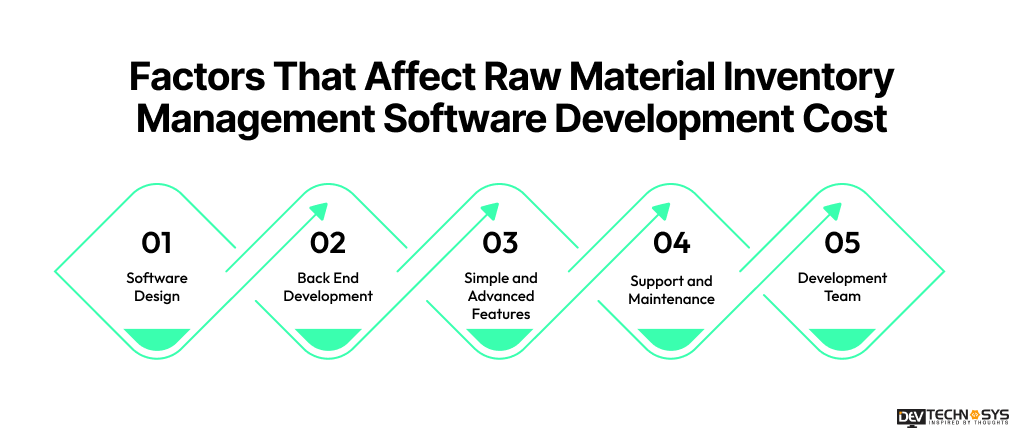
1. Software Design
The intricacy of the user interface, user experience features, and bespoke graphics has a substantial influence on AI inventory management software development cost. A basic, straightforward design is less expensive, but a distinctive and engaging interface with responsive features necessitates more time, talented designers, and greater investment to ensure functioning across several devices and screen sizes.
Design Quality |
Cost Estimation |
| Basic Design | $8,000 – $12,000 |
| Complex Design | $15,000 – $22,000 |
2. Back End Development
Back-end complexity effects cost since it entails developing databases, APIs, server logic, and security mechanisms. Scalable architecture and real-time data processing necessitate more skilled developers and powerful technological stacks, which raises total raw material inventory management software development cost. Back-end systems must be efficient, safe, and scalable in order for software to work reliably.
Backend Development |
Cost Estimation |
| Basic Backend Process | $10,000 – $18,000 |
| Premium Backend Process | $20,000 – $28,000 |
3. Simple and Advanced Features
Basic inventory tasks are less expensive to implement, but sophisticated capabilities like as AI-based forecasting, real-time tracking, and system interconnections increase the cost to build warehouse management software. The more sophisticated and personalized the features, the longer the development time, testing effort, and cost owing to increased functionality and performance considerations.
Features |
Cost Estimation |
| Core Features(Real-Time Inventory Tracking and Automated Reordering) | $8,000 – $10,000 |
| Advanced Features(AI-Powered Demand Forecasting and Batch and Lot Tracking) | $13,000 – $19,000 |
4. Support and Maintenance
Post-launch support, monthly upgrades, bug patches, and system advancements all have continuing expenditures and it can increase the raw material inventory management software development cost.
Businesses must spend on maintenance to ensure peak performance, handle security concerns, and react to changing business requirements. The more complicated the program, the greater the continuous maintenance and support expenditures necessary to keep it operational.
Maintenance Phase |
Cost Estimation |
| Simple Maintenance Phase | $2,000 – $4,000/year |
| Complex Maintenance Phase | $7,000 – $9,000/year |
5. Development Team
The pricing varies according to team size, competence, and geographical location. Hiring developers from expensive locations or top-tier companies boosts the cost of custom software development services. While freelancers or offshore teams may save money, they may compromise quality or delivery speed. A well-balanced, talented team produces greater results and longer-term software reliability.
Developer’s Experience Level |
Cost Estimation |
| Entry-Level Developer | $15 – $18/ Per Hour |
| Mid-Level Developer | $18 – $22/ Per Hour |
| Senior-Level Developer | $25+ / Per Hour |
5 Best Monetization Techniques of Raw Material Inventory Management Software
Each of these monetization strategies can be combined or tailored depending on your target market and product scalability goals. Here are the 5 best monetization techniques for raw material inventory management software:
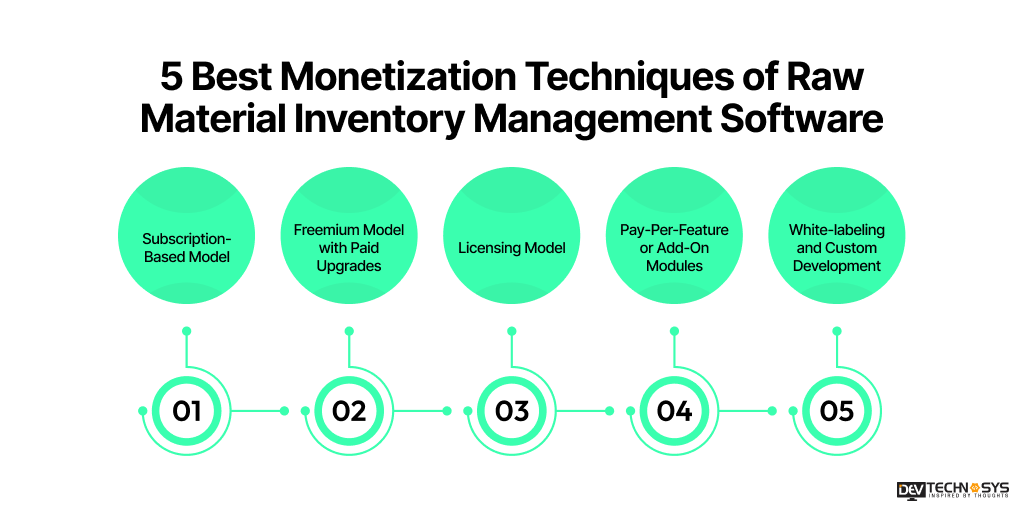
1. Subscription-Based Model
This is the most popular and reliable monetization method. Businesses pay a monthly or yearly price to use the program, with pricing tiers determined by functionality, number of users, or warehouse locations. This strategy assures consistent recurring revenue and fosters long-term client connections while allowing businesses to increase their usage as needed.
2. Freemium Model with Paid Upgrades
Raw material inventory management software development solutions offer a free basic version with minimal features, which attracts consumers rapidly. Premium features, such as sophisticated analytics, AI forecasting, and multi-warehouse support, are sold or upgraded in-app to generate revenue. This approach is ideal for startups or small manufacturers that evolve into bigger subscription tiers over time.
3. Licensing Model
On-premise installations may incur a one-time license price, particularly for big companies with stringent data security requirements. Businesses purchase the software once and may be charged extra for upgrades or annual support. This strategy is appropriate for highly customized or secure installations in which cloud options are not optimal.
4. Pay-Per-Feature or Add-On Modules
Core inventory management is provided as a base package, with extra capabilities such as supplier analytics, mobile access, and ERP connectivity sold separately. According to the software product development company, this modular approach enables clients to create a customized solution while you profit from value-added capabilities over time.
5. White-labeling and Custom Development
License the program to third-party sellers, who can rename it or request new modules. Charging for customisation, white-label rights, or private deployment solutions may produce substantial revenue, particularly when targeting specialty sectors or overseas markets with strict compliance requirements.
Conclusion
To sum up, companies trying to guarantee manufacturing efficiency, cut waste, and simplify processes need Raw Material Inventory Management Software. Real-time tracking, automation, and predictive analytics help to empower improved cost control and decision-making.
Purchasing this program pays long-term financial and operational gains. Working with a trustworthy warehouse management software development company can help you to speed up the development process and guarantee a scalable, user-friendly, feature-rich solution fit for your corporate requirements.
Customized inventory systems become a wise, strategic move for contemporary manufacturing and supply chain management as businesses get more complicated.
Frequently Asked Questions
1. How Much Does it Cost to Build a Raw Material Inventory Management Software?
The cost to develop a raw material inventory management software typically ranges from $8,000 to $25,000, depending on features, complexity, platform, and development team location. Customization and integration increase the overall price.
2. How Much Time Does It Take To Make a Raw Material Inventory Management Software?
To make a raw material inventory management software usually takes 3 to 6 months, depending on complexity, features, team size, and technology stack. Custom features, integrations, and testing can extend the development timeline.
3. What Technologies are Required to Create a Raw Material Inventory Management Software?
Technologies required include a backend language (Node.js, Python, or Java), frontend frameworks (React, Angular), database systems (MySQL, MongoDB), cloud services (AWS, Azure), APIs, authentication tools, and possibly mobile development tools.
4. Can it integrate with ERP or Accounting Systems?
Yes, raw material inventory management software can integrate with ERP or accounting systems, enabling seamless data flow, real-time inventory updates, financial tracking, and streamlined supply chain management across multiple platforms.
5. Can the Software Handle Multiple Warehouse Locations?
Yes, raw material inventory management software can handle multiple warehouse locations, allowing real-time tracking, stock transfers, and centralized reporting across different sites, improving inventory accuracy and logistics management.
